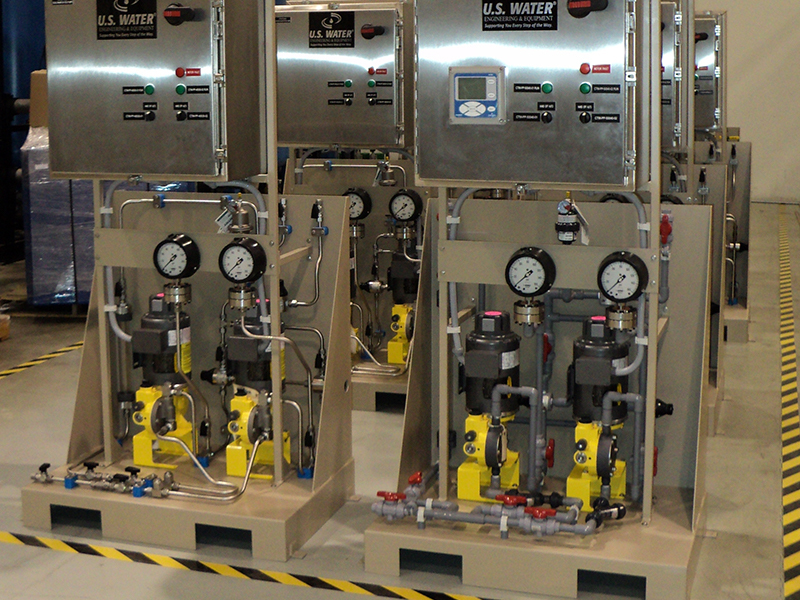Chemical feed skids offer reliable and consistent dosing of chemicals into process applications. When designed correctly, chemical feed skids have the ability to increase system productivity by maximizing operating costs and reducing chemical costs. Available in hundreds of configurations, U.S. Water's chemical feed skids are customized to meet each facility's unique application and specifications.
There are many factors both facilities and chemical skid manufacturers must consider when selecting chemical feed skid components for the oil and gas industry. Due to the industry's demanding environment, delivering chemical in a safe and reliable manner can be challenging. Chemical feed skids must be built with the proper equipment and accessories to ensure accurate operation and system integrity.
Pipelines and other process related treatment programs are often considered a Classified Area, therefore the chemical feed system must meet specific classifications as set by industry regulatory bodies, such as the National Fire Protection Association (NFPA), American Petroleum Institute (API), the International Fire Code or Underwriter Laboratories (UL). The classification assigned to that area is a reflection of the potential for fire or explosion. In typical conditions, there is a low probability of explosive mixture and the area is classified as Class I, Division 2, Group D. Sometimes there is a high probability of explosive mixture and the area is labeled a Class I, Division 1, Group D. Classification requirements will determine the chemical system's motor, junction box and electrical control panel. Plants should work closely with an engineering firm to ensure the designed system meets all classifications, as chemical feed systems are subject to 3rd party inspections.
Chemical pumps provide consistent chemical delivery, and the wide variety of pumps available on the market can be overwhelming. The pump selection should be based on the desired feed rate, dosing pressure, chemical compatibility and viscosity/specific gravity. Pumps can be shipped loose for installation by others, or skid mounted with the rest of the chemical feed program accessories piped in.
There is a variety of equipment and accessory combinations available to create the most convenient and efficient system. Below you will find commonly used accessories for the oil and gas industry:
- Strainer: Filters sediments and other large particulate matter that can cause damage to the pump. They are highly recommended as the injection point has a finer tip.
- Pressure Relief Valves: An underutilized safety measure that relieves built-up pressure should an outlet isolation valve on the pump be closed, a line blockage occur, or some other accessory fail causing pressure to build on the outlet of the pump.
- Back Pressure Valve: Prevents unintentional siphoning of chemical.
- Injection Setup: Injection quills and atomizers connect the chemical feed system to the treated system, and are essential in getting the treatment into the middle of the pipeline. Atomizers are utilized when feeding into gas streams as they aerosolize the product. Injection quills are often utilized when feeding into liquid streams.
- Calibration Column: A gauge to determine how fast the liquid is moving to avoid damaging the system. An accurate measure of the flow rate prevents underfeed or overfeed of chemicals.
- Pressure Gauge: A tool to verify the pump performance and system design.
- Flow Verification Sensor: Not commonly used, but provides an automated way to verify actual feed rate.
- Pulsation Dampener: Provides a smooth flow by reducing “pulses” and strain on the piping or system elements due to fluctuation in pressure.
- Pipe Material: Stainless steel is recommended for non-water treatment chemistries.
Learn more about U.S. Water's chemical feed skid capabilities here.

